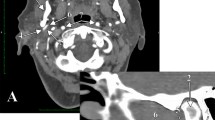Abstract
This case report describes the coexistence of a retroesophageal right subclavian artery and left maxillary artery which passed deep to the mandibular nerve. An 88-year-old woman died of acute heart failure, and the postmortem revealed that the right subclavian artery originated from the aortic arch as the last branch at the level of the fourth thoracic vertebra, then passed between the esophagus and the vertebral column. The artery then ascended right superiorly and passed behind the anterior scalene muscle. The right vertebral artery arose from the retroesophageal right subclavian artery and entered the transverse foramen of the sixth cervical vertebra. The left maxillary artery branched at the common trunk of the posterior deep temporal and the inferior alveolar arteries. The maxillary artery then turned anteromedially and branched to give the middle meningeal artery. The mandibular nerve gave off the buccal nerve, deep temporal nerve and a thick nerve just below the foramen ovale. The auriculotemporal nerve that branched from the thick nerve ran deep to the maxillary artery. The maxillary artery turned anteriorly, passing deep to the branches. The artery then split to give the buccal artery and the anterior deep temporal artery. In the pterygopalatine section, the maxillary artery branched off to form the common trunk of the infraorbital and sphenopalatine arteries and the posterior superior alveolar artery. It may be necessary to pay attention to the course of the maxillary artery and its relationship to the mandibular nerve branches, when a retroesophageal right subclavian artery is seen.


Similar content being viewed by others
Data availability
Not applicable.
References
Adachi B (1928) Das arteriensystem der Japaner. Band I. In: Adachi B (ed) A maxillaris interna. Maruzen, Kyoto, pp 85–96
Aland RC, Shaw V (2016) Divided maxillary artery in relation to the lateral pterygoid muscle. Anat Sci Int 91:207–210
Dias GJ, Koh JMC, Cornwall J (2015) The origin of the auriculotemporal nerve and its relationship to the middle meningeal artery. Anat Sci Int 90:216–221
Fujita T (1932) Über einen Fall von beiderseitig medial vom N. mandibularis verlaufender A. maxillaris interna, nebst einer statistik der verlaufsvariation der arterie (in Japanese). J Stomatol Soc Jpn 6:250–252
Ito T, Itoh A, Kiyoshima D, Ikeda Y (2022) Anatomical characteristics of two cases of aberrant right subclavian artery. Anat Sci Int 97:423–427
Iwanaga J, Badaloni F, Laws T, Oskouian RJ, Tubbs RS (2018) Anatomic study of extracranial needle trajectory using hartel technique for percutaneous treatment of trigeminal neuralgia. World Neurosurg 110:245–248
Kaidoh T, Inoué T (2011) Simultaneous occurrence of an aberrant right subclavian artery and accessory lobe of the liver. Anat Sci Int 86:171–174
Kawai K, Honma S, Kumagai Y, Koba Y, Koizumi M (2011) A schematic diagram showing the various components of the embryonic aortic arch complex in the retroesophageal right subclavian artery. Anat Sci Int 86:135–145
Kodama K (2000) Maxillary artery. In: Sato T, Akita K (eds) Anatomic variations in Japanese. University of Tokyo Press, Tokyo, pp 208–209
Maeda S, Aizawa Y, Kumaki K, Kageyama I (2012) Variations in the course of the maxillary artery in Japanese adults. Anat Sci Int 87:187–194
Natsis K, Didagelos M, Gkiouliava A, Lazaridis N, Vyzas V, Piagkou M (2017) The aberrant right subclavian artery: cadaveric study and literature review. Surg Radiol Anat 39:559–565
Okamoto K, Wakebe T, Saiki K, Tsurumoto T (2013) A case of retroesophageal right subclavian artery, with special reference to the second intercostal artery, retroesophageal right vertebral artery, and thoracic duct. Anat Sci Int 88:234–238
Padget DH (1948) The development of the cranial arteries in the human embryo. Contrib Embryol 32:205–261
Tadokoro O, Umemura Y, Utsuno H, Inoue K (2008) A case of a divided maxillary artery in the infratemporal fossa. Okajimas Folia Anat Jpn 85:97–101
Tanaka S, Inoue K, Tanaka R, Kawai K, Shimoda S, Kodera H, Goto M, Kawasaki K, Sato T (2003) Maxillary artery passing among the branches from the mandibular nerve in a Japanese man (in Japanese). Tsurumi Univ Dent J 29:187–191
Verma S, Fasil M, Murugan M, Sakkarai J (2014) Unique variation in the course of maxillary artery in infratemporal fossa: a case report. Surg Radiol Anat 36:507–509
Acknowledgements
The author sincerely thanks those who donated their bodies to science so that anatomical research can be performed. Results from such research can potentially increase mankind's overall knowledge, and consequently improve patient care. Therefore, the donor and the family in our case deserve our highest gratitude. The author thanks Shingo Maeda for his helpful comment and Jiro Yoshi, the technical staff for the dissection practice assistance. The author thanks Dr Tanya Franzen for proofreading this manuscript.
Author information
Authors and Affiliations
Corresponding author
Ethics declarations
Conflict of interest None.
Ethical approval The present work was performed in accordance with the requirements of the Declaration of Helsinki (64th WMA General Assembly, Fortaleza, Brazil, October 2013).
Additional information
Publisher's Note
Springer Nature remains neutral with regard to jurisdictional claims in published maps and institutional affiliations.
Rights and permissions
Springer Nature or its licensor (e.g. a society or other partner) holds exclusive rights to this article under a publishing agreement with the author(s) or other rightsholder(s); author self-archiving of the accepted manuscript version of this article is solely governed by the terms of such publishing agreement and applicable law.
About this article
Cite this article
Tadokoro, O. Coexistence of a retroesophageal right subclavian artery with a left maxillary artery medial to the mandibular nerve. Anat Sci Int (2024). https://doi.org/10.1007/s12565-024-00763-9
Received:
Accepted:
Published:
DOI: https://doi.org/10.1007/s12565-024-00763-9




